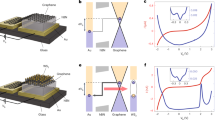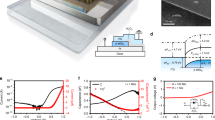Abstract
Atomically thin materials can be used to build novel forms of conventional semiconductor heterostructure devices. One such device is a resonant tunnelling diode, which can exhibit negative differential resistance and usually consists of a quantum-well structure between two barrier layers. Here, we show that a twisted black phosphorus homostructure can be used to create a resonant tunnelling diode. The devices have a trilayer structure in which a thin non-degenerate black phosphorus layer is sandwiched between two thicker degenerate black phosphorus layers. The interlayer coupling strength depends sensitively on the twist angle between the layers, and thus the twist angle can be used to control the vertical transport behaviour, from ohmic to tunnelling. Because resonant tunnelling through quantum-well states occurs without the need for a physical tunnelling barrier, our devices exhibit a higher tunnelling conductance and negative differential resistance peak-to-valley current ratio than resonant tunnelling diodes based on van der Waals heterostructures.
This is a preview of subscription content, access via your institution
Access options
Access Nature and 54 other Nature Portfolio journals
Get Nature+, our best-value online-access subscription
$29.99 / 30 days
cancel any time
Subscribe to this journal
Receive 12 digital issues and online access to articles
$119.00 per year
only $9.92 per issue
Buy this article
- Purchase on Springer Link
- Instant access to full article PDF
Prices may be subject to local taxes which are calculated during checkout




Similar content being viewed by others
Data availability
The data that support the plots within this paper and other findings of this study are available from the corresponding authors upon reasonable request.
Change history
09 July 2021
A Correction to this paper has been published: https://doi.org/10.1038/s41928-021-00621-w
References
Kluksdahl, N. C., Kriman, A. M. & Ferry, D. K. Self-consistent study of the resonant-tunnelling diode. Phys. Rev. B 39, 7720–7735 (1989).
Mendez, E. E., Wang, W. I., Ricco, B. & Esaki, L. Resonant tunnelling of holes in AlAs–GaAs–AlAs heterostructures. Appl. Phys. Lett. 47, 415–417 (1985).
Schmidt, O. G. et al. Resonant tunnelling diodes made up of stacked self-assembled Ge/Si islands. Appl. Phys. Lett. 77, 4341–4343 (2000).
Izumi, R., Sato, T., Suzuki, S. & Asada, M. Resonant-tunnelling-diode terahertz oscillator with a cylindrical cavity for high-frequency oscillation. AIP Adv. 9, 085020 (2019).
Alkeev, N. V., Averin, S. V., Dorofeev, A. A., Golant, E. I. & Pashkovskii, A. B. New terahertz mixer based on resonant-tunneling diode. In Proc. 2007 International Kharkov Symposium Physics and Engineering of Millimeter and Sub-Millimeter Waves (MSMW) 192–194 (IEEE, 2007).
Alkeev, N. V., Averin, S. V., Dorofeev, A. A., Gladysheva, N. B. & Torgashin, M. Y. GaAs/AlAs resonant-tunnelling diode for subharmonic mixers. Russ. Microelectron. 39, 331–339 (2010).
Fan, S. et al. Tunable negative differential resistance in van der Waals heterostructures at room temperature by tailoring the interface. ACS Nano 13, 8193–8201 (2019).
Nourbakhsh, A., Zubair, A., Dresselhaus, M. S. & Palacios, T. Transport properties of a MoS2/WSe2 heterojunction transistor and its potential for application. Nano Lett. 16, 1359–1366 (2016).
Yan, R. et al. Esaki diodes in van der Waals heterojunctions with broken-gap energy band alignment. Nano Lett. 15, 5791–5798 (2015).
Kim, K. et al. Spin-conserving resonant tunnelling in twist-controlled WSe2-hBN-WSe2 heterostructures. Nano Lett. 18, 5967–5973 (2018).
Burg, G. W. et al. Coherent interlayer tunnelling and negative differential resistance with high current density in double bilayer graphene–WSe2 heterostructures. Nano Lett. 17, 3919–3925 (2017).
Xiong, X. et al. A transverse tunnelling field-effect transistor made from a van der Waals heterostructure. Nat. Electron. 3, 106–112 (2020).
Shim, J. et al. Phosphorene/rhenium disulfide heterojunction-based negative differential resistance device for multi-valued logic. Nat. Commun. 7, 13413 (2016).
Srivastava, P. K. et al. Multifunctional van der Waals broken-gap heterojunction. Small 15, 1804885 (2019).
Mishchenko, A. et al. Twist-controlled resonant tunnelling in graphene/boron nitride/graphene heterostructures. Nat. Nanotechnol. 9, 808–813 (2014).
Britnell, L. et al. Resonant tunnelling and negative differential conductance in graphene transistors. Nat. Commun. 4, 1794 (2013).
Fallahazad, B. et al. Gate-tunable resonant tunnelling in double bilayer graphene heterostructures. Nano Lett. 15, 428–433 (2015).
Luo, Z. et al. Anisotropic in-plane thermal conductivity observed in few-layer black phosphorus. Nat. Commun. 6, 8572 (2015).
Lee, S. et al. Anisotropic in-plane thermal conductivity of black phosphorus nanoribbons at temperatures higher than 100 K. Nat. Commun. 6, 8573 (2015).
Li, L. et al. Quantum oscillations in a two-dimensional electron gas in black phosphorus thin films. Nat. Nanotechnol. 10, 608–613 (2015).
Li, L. et al. Black phosphorus field-effect transistors. Nat. Nanotechnol. 9, 372–377 (2014).
Li, L. et al. Quantum Hall effect in black phosphorus two-dimensional electron system. Nat. Nanotechnol. 11, 593–597 (2016).
Hu, Z. X., Kong, X., Qiao, J., Normand, B. & Ji, W. Interlayer electronic hybridization leads to exceptional thickness-dependent vibrational properties in few-layer black phosphorus. Nanoscale 8, 2740–2750 (2016).
Mattevi, C. et al. Evolution of electrical, chemical and structural properties of transparent and conducting chemically derived graphene thin films. Adv. Funct. Mater. 19, 2577–2583 (2009).
Liu, X. et al. Modulation of quantum tunnelling via a vertical two-dimensional black phosphorus and molybdenum disulfide p–n junction. ACS Nano 11, 9143–9150 (2017).
Gaberle, J. & Shluger, A. L. Structure and properties of intrinsic and extrinsic defects in black phosphorus. Nanoscale 10, 19536–19546 (2018).
Kou, L., Ma, Y., Smith, S. C. & Chen, C. Anisotropic ripple deformation in phosphorene. J. Phys. Chem. Lett. 6, 1509–1513 (2015).
De Sousa, D. J. P., De Castro, L. V., Da Costa, D. R., Pereira, J. M. & Low, T. Multilayered black phosphorus: from a tight-binding to a continuum description. Phys. Rev. B 96, 155427 (2017).
Cao, T., Li, Z., Qiu, D. Y. & Louie, S. G. Gate switchable transport and optical anisotropy in 90° twisted bilayer black phosphorus. Nano Lett. 16, 5542–5546 (2016).
Liu, N., Zhang, J., Zhou, S. & Zhao, J. Tuning the electronic properties of bilayer black phosphorene with the twist angle. J. Mater. Chem. C 8, 6264–6272 (2020).
Perdew, J. P., Burke, K. & Ernzerhof, M. Generalized gradient approximation made simple. Phys. Rev. Lett. 77, 3865–3868 (1996).
Shishkin, M. & Kresse, G. Self-consistent GW calculations for semiconductors and insulators. Phys. Rev. B 75, 235102 (2007).
Perdew, J. P. Density functional theory and the band gap problem. Int. J. Quantum Chem. 28, 497–523 (1985).
Low, T. et al. Plasmons and screening in monolayer and multilayer black phosphorus. Phys. Rev. Lett. 113, 106802 (2014).
Bhattacharyya, S. et al. Resonant tunnelling and fast switching in amorphous-carbon quantum-well structures. Nat. Mater. 5, 19–22 (2006).
Schuberth, G. et al. Resonant tunnelling of holes in Si/SixGe1 − x quantum-well structures. Phys. Rev. B 43, 2280 (1991).
Rudenko, A. N., Yuan, S. & Katsnelson, M. I. Toward a realistic description of multilayer black phosphorus: from GW approximation to large-scale tight-binding simulations. Phys. Rev. B 92, 199906 (2015).
Rudenko, A. N. & Katsnelson, M. I. Quasiparticle band structure and tight-binding model for single- and bilayer black phosphorus. Phys. Rev. B 89, 201408R (2014).
Pereira, J. M. & Katsnelson, M. I. Landau levels of single-layer and bilayer phosphorene. Phys. Rev. B 92, 075437 (2015).
Sevik, C., Wallbank, J. R., Gülseren, O., Peeters, F. M. & Çakir, D. Gate induced monolayer behavior in twisted bilayer black phosphorus. 2D Mater. 4, 035025 (2017).
Vdovin, E. E. et al. Phonon-assisted resonant tunnelling of electrons in graphene–boron nitride transistors. Phys. Rev. Lett. 116, 186603 (2016).
Shen, G. D., Xu, D. X., Willander, M. & Hansson, G. V. The origin of the temperature dependence in resonant tunnelling transport. In Proc. 1991 IEEE/Cornell Conference on Advanced Concepts in High Speed Semiconductor Devices and Circuits 84–93 (IEEE, 1991)
Ridley, B. K. Quantum Processes in Semiconductors 4th edn (Oxford Univ. Press, 1999).
Choi, W. S., Lee, S. A., You, J. H., Lee, S. & Lee, H. N. Resonant tunnelling in a quantum oxide superlattice. Nat. Commun. 6, 7424 (2015).
Nguyen, L. N. et al. Resonant tunnelling through discrete quantum states in stacked atomic-layered MoS2. Nano Lett. 14, 2381–2386 (2014).
Li, L. L., Partoens, B. & Peeters, F. M. Tuning the electronic properties of gated multilayer phosphorene: a self-consistent tight-binding study. Phys. Rev. B 97, 155424 (2018).
Forte, J. D. S., de Sousa, D. J. P. & Pereira, J. M. Dirac spectrum in gated multilayer black phosphorus nanoribbons. Physica E 114, 113578 (2019).
Acknowledgements
This research was supported by the Basic Science Research Program through the National Research Foundation of Korea (NRF; grants NRF-2016K1A1A2912707, 2016R1A6A3A11934734, 2016R1A2B4012931, 2018R1D1A1B07049669, 2019R1I1A1A01061466 and 2020R1A2C2014687), funded by the Ministry of Science and ICT of Korea, Samsung Research Funding Center of Samsung Electronics (project no. SRFC-TB1803-04) and the KISTI supercomputing centre (grant no. KSC-2018-CRE-0119).
Author information
Authors and Affiliations
Contributions
B.S., P.K.S. and C.L. conceived the project. Y.H. prepared the devices with help from Y.Z. for electron-beam lithography. P.K.S. and Y.H. carried out electrical measurements. D.J.P.d.S. and T.L. carried out quantum transport simulations. Y.G. and M.J. carried out DFT calculations for twisted and non-twisted BP bilayer band structures. F.A. and W.J.Y. helped with the glove box facility and its use. P.K.S., D.J.P.d.S., S.G., J.T.T., B.S., T.L. and C.L. discussed and analysed the data. P.K.S., C.L., B.S., D.J.P.d.S. and T.L. co-wrote the manuscript. All authors discussed the results and commented on the manuscript.
Corresponding authors
Ethics declarations
Competing interests
The authors declare no competing interests.
Additional information
Peer review information Nature Electronics thanks Yuerui Lu and the other, anonymous, reviewer(s) for their contribution to the peer review of this work.
Publisher’s note Springer Nature remains neutral with regard to jurisdictional claims in published maps and institutional affiliations.
Supplementary information
Supplementary Information
Supplementary Figs. 1–6, Discussion and Tables 1–3.
Rights and permissions
About this article
Cite this article
Srivastava, P.K., Hassan, Y., de Sousa, D.J.P. et al. Resonant tunnelling diodes based on twisted black phosphorus homostructures. Nat Electron 4, 269–276 (2021). https://doi.org/10.1038/s41928-021-00549-1
Received:
Accepted:
Published:
Issue Date:
DOI: https://doi.org/10.1038/s41928-021-00549-1
This article is cited by
-
Femtosecond electron beam probe of ultrafast electronics
Nature Communications (2024)
-
Two-dimensional materials based on negative differential transconductance and negative differential resistance for the application of multi-valued logic circuit: a review
Carbon Letters (2023)
-
Black-phosphorus-based junctions and their optoelectronic device applications
Nano Research (2023)
-
Electrochemically exfoliated phosphorene nanosheet thin films for wafer-scale near-infrared phototransistor array
npj 2D Materials and Applications (2022)
-
First-principle studies of twisted bilayer black phosphorus
Journal of the Korean Physical Society (2022)



